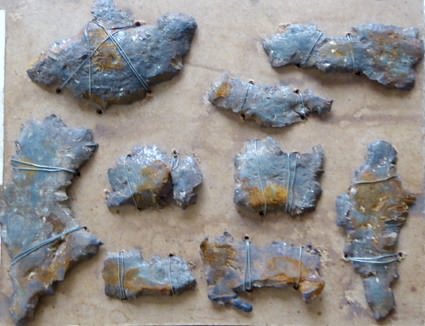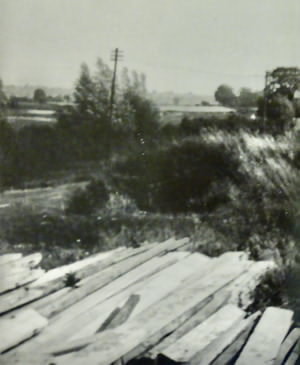|
First Hand accounts of the raid:-
Many
residents over the years have only mentioned either a single bomb
or a cluster of bombs which fell in the vicinity of Nayland Rd,
destroying the Willinghams family home by the blast.
There
appears to be some confusion on which way the bombing run took
place
Here
we have four accounts of the bombing run?
No1.
I interviewed Mary Anderson in early 2,000 and she told me:
My father told me he had seen a German plane heading towards
the village when he was standing at the back door. He pushed me
indoors and told me to get down on the floor. We then heard the
terrible sound of screeching then a series of horrendous bangs.
When it was all quiet, I walked down the road with my father to
find the first bomb hit the house another in the middle of the
road and other across the field opposite
The Willingham children, fortunately, were in school at the time
of the bombing.***
***This has been documented in numerous places, but it`s incorrect
the youngest child Eva would have been 29.
No2
Another
interview with Arthur Beaumont told me this:
“ I was delivery a set of batteries to a lady at the top of
Wormingford Hill when I saw a plane coming over the fields towards
me. From the sound of the engine, it was a German.
He continued towards Assington, he then banked around and headed
back towards Bures, I then heard a series of bangs. When I returned
to the village, Nayland Road was blocked.
The
direction of the bombing run.
The first bomb in Nayland road and the last in Colchester road
No3
Account by Stephen Barr of Malmesbury, Wiltshire. Parents lived along Colchester
Rd.
During the early 1940`s we were
advised to move away from our house between St Osyth and Clacton
due to the war situation and so we arrived at Bures for safety.
Consequently my Grand Parents rented
a bungalow on Colchester Road and were at home when the bombing
occurred.
From what my family has told me, I can pass on the following:
The bombing happened around tea
time so it was dark. The lights of the factory, to the north of
the village, were seen to be switched on without any black-out
precautions. With the rest of the village in total darkness it
must have stood out like a beacon.
The reason for this has
never been explained.
I think that it was a targeted
air strike on the factory and not simply the aircraft getting
rid of unwanted bombs.
My father recalls the noise of an aircraft in a steep dive, followed
by a series of loud explosions. There was no warning other than
the noise of the aircraft.
The front door was blasted
down the hall by the bombs. As already mentioned the family were
about to have their evening tea/meal. The children had sat down
at the table ready to start eating.
My Gran had managed to "obtain" a honey comb (not easy
with rationing) as a special treat for the children which she
placed on a plate in the centre of the table.
The children were very-much looking forward to eating it. This
is the point when the aircraft was heard in a steep dive and so
my gran and her mother each leaned over the children to try to
give them some protection. There was no time to do anything else.
As you probably know German aircraft tended to sound different
to British ones and so my Gran knew something bad was about to
happen.
When the bombs went off the glass light fitting above the lounge
table came crashing down directly into the honey comb and ruined
it with broken glass splinters.
My family say that a bomb landed on Colchester road, blocked the
road.
The property was damaged by the
blast, the whole roof structure shifted 5 inches, all the windows
were broken and the doors blown off.
It was so badly damaged was uninhabitable
until being rebuilt after the war.
One of the bombs
only just missed a pile of bricks on the building site next door
( left side of bungalow)
In Nov. 1940 the ground was fairly damp so where the bombs hit
soil they tended to go down a long way before exploding and so
shielding much of the blast.
People at the time said that if the bomb had hit the pile of bricks
there would in effect have been a kind of "air burst"
explosion and my family would have all been killed. As a result
only my Grandfather would have survived as he was at work in Clacton
at the time.
My father suffered serious hearing
damage which he never recovered from. He also had nightmares which
lasted into the 1970 as result of this and other things that happened
in the war.
It is my understanding that a stick of 10 bombs were dropped with
the first ones landing near where my family were living on the
Essex side of Bures, Colchester road. Some landed in the meadows
next to the river, between the 2 sides of the village and the
final 1 or 2 landing on or near the council house on Nayland road
where the 4 people were killed. In other words the bombings on
Colchester road and Nayland road were both part of the same air
raid.
I have, seen it suggested that there were anywhere between 4 and
10 bombs dropped but I would think that the correct figure is
10 or nearly 10 judging by the damage.
There is also some confusion about the date of the raid as I have
seen it stated as being anywhere between the 5th and 11th November
1940. ( ed:- the insurance claim date this as Nov 6th )
My Grandfather was at work when the raid happened and when he
got home to a seen of total devastation my Gran said "we've
been bombed" my Grandfather replied "I thought
something had happened".
My Grand Parents moved out the
next morning, after spending a night with some people just down
the road.
That day they also found some alternative accommodation.
No4
An
account from John Barr, Uncle of Stephen Barr
My
first real memory was standing in the near darkness of the hall
with the family, except my father who was still on his way home
and shivering (cold /fear). At that point, someone found my coat
(brown with a velvet collar I think) and we were just looking
at the hole where the front door had been when someone (ARP?)
ran up to the opening and called out to check if everyone was
alright.
The
next I remember was when we were in the front garden, which was
not the same, but just a pile of earth and what I found strange
was that we did not have to go out of our gate and in through
our neighbours gate but just walked over the earth and we were
there.
I
believe the next-door house was not badly damaged and their children
were possibly told to keep us two amused which they did with the
help of a wind-up gramophone and one or maybe two records.
I
have no direct memory before this of the sound of the bombs etc.
but was told about it later. Also, I cannot remember anything
after the gramophone for some years.
I
was told that Lesley and I were put to bed in the small room at
the back of the house (the windows were protected with a stick-on
netting) whilst our parents stayed up all night planning the move
back to our own house.
The
next day I think I got in everyone's way because I wanted to hunt
for the honeycomb which I seemed to think was behind the sofa.
I grew up with the firm idea that the raid was all about the attack
on the honeycomb.
Acknowledgement
to John Barr for allowing me to print this account
=====================================================
From
this account, the Barr family states that Colchester Rd was first
to be hit.
However, the general consensus is the Willingham house was the
first to be damaged.
Arthur Beamont when visiting Wormingford, recalls how he watched
the German bomber flying low from the Assington direction, dropping
its first bomb on Nayland Road.
There is aslo conflicting stories of how many bombs fell, ranging
from seven to ten
Seven would seem the most plausible.
Whatever the reason for the attack, everyone agrees the Factory
was the target, as it ignored the blackout instructions.
|
|
|
|
This is
the bungalow photographed during 2014
|
Bungalow
dated circa 1940
Home of the "Barr" family
|
|

Shrapnel of the German Bomb
The thickness
of the bomb splinters indicating a thin case bomb specifically
designed to cause maximum blast damage for it’s size/weight
but having a poor ability to penetrate thick/reinforced
concrete.
The bomb splinters are mounted on a piece of hardboard,
by wire, just as a means to display them and keep them together.
Stephen Barr
|

The bomb crater is on the building plot next door (centre
of image) to the bungalow. The pile of wood is amongs`t
the materials already on site for construction work to
commence on the new property which in the event didn’t
happen until after the war ended in 1945
One of the bombs narrowly missed a pile of stacked bricks.
My understanding is that
this building plot is on the other side of the bungalow
to the village and you can just make out the Colchester
Road in the photo which confirms this.
|
|
![]()

